Preventing 48RE Transmission Throttle-Valve-Actuator Codes
In 2005, Dodge started using a transmission throttle-valve actuator (TTVA) instead of a TV cable on the 48RE diesel 2500 and 3500 Ram trucks. The actuator, attached to the case above the throttle-valve shaft, includes two potentiometers that provide input to the ECM as well as a DC motor that responds to ECM output. The bottom of the TTVA shaft features a D-shaped opening that fits onto the throttle shaft, allowing the actuator to mechanically stoke the TV valve and ultimately control transmission throttle pressure.
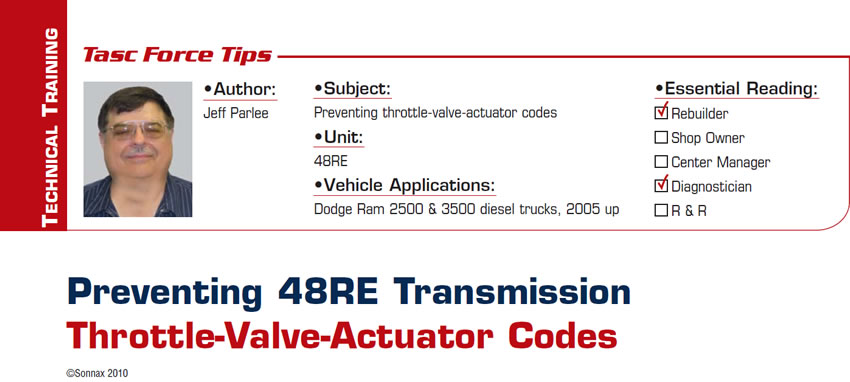
AW55-50: No Reverse; 09G/09K/09M: No Movement
I recently received a phone call from a shop that was working on a 2001 Volvo with an AW 55-50 transmission. The vehicle would not move when shifted from Park to Reverse. If the selector was first put into Drive then moved to Reverse, engagement was normal. The manual linkage was checked, confirming that the manual valve was in the reverse position.
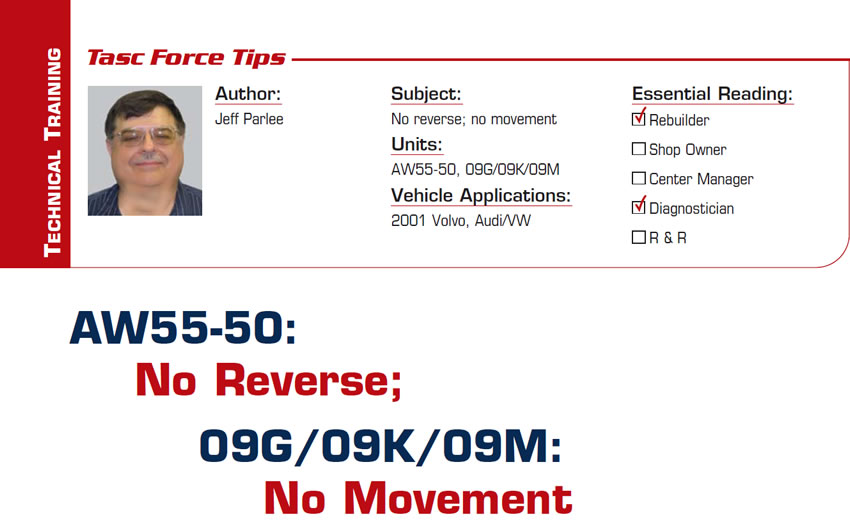
RE5R05A Facts and Observations
This transmission has been on the street since 2002, when it was first used in the Infiniti Q45 with the 4.5-liter engine. Since then, Infiniti and Nissan have used this transmission in many models. There are three versions of the RE5R05A valve body…
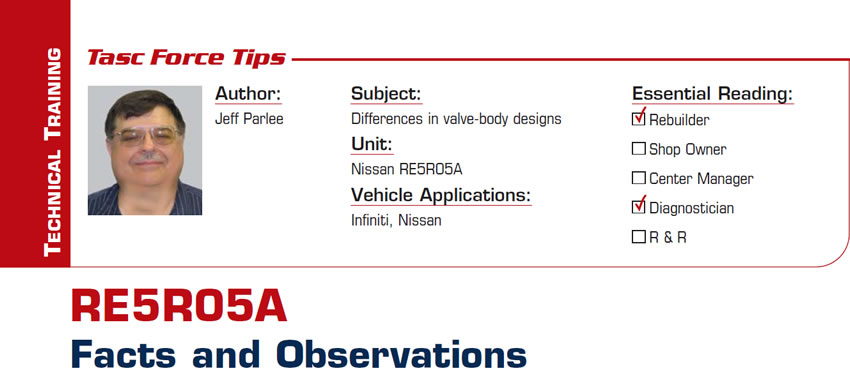
U151/U250 Solenoid Information
The U151 and U250 are five-speed transaxles that are used in the Lexus ES300, ES330, RX330 and RX350 as well as many Toyota vehicles from 2004 on. The U250 is used behind the 2.4-liter four-cylinder engine, and the U151 is used behind the 3.0-, 3.3- and 3.5-liter V-6 engines. The U151E and the U250E are front-wheel-drive transaxles, and the U151F is an all-wheel-drive transaxle.

Toyota U140/U240 Series Diagnostic Information
This transmission has some unique problems that can cause you to scratch your head. Add the lack of information available from the manufacturer and your frustration level can skyrocket. Here are some common problems and suggestions on how to resolve them.
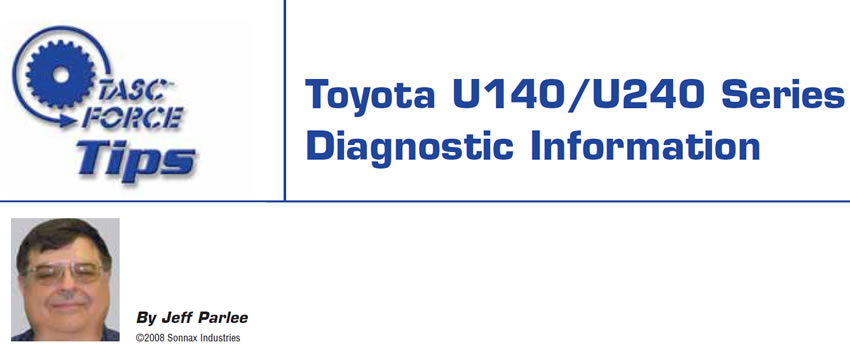
AW55-50: Differences Among Manufacturers, Part 2
Last month we explained the variety of operating modes the different manufacturers use to control AW55-50 units in their vehicles. Knowing the modes and when they are activated is the first step in making an accurate diagnosis. A symptom reported by a customer may be normal, intended operation for one brand of vehicle and a legitimate problem in another. As part of your diagnosis, you also should be aware that every manufacturer has at least one transmission-control-module (TCM) reflash or replacement bulletin to address various transmission concerns.

AW55-50: Differences Among Manufacturers, Part 1
As you can see, there are a lot of these transmissions on the street. It is important that you understand what a normal operating condition is and what is not normal for the vehicle that you are working on. Not all AW55-50 transmissions have the same operating features.
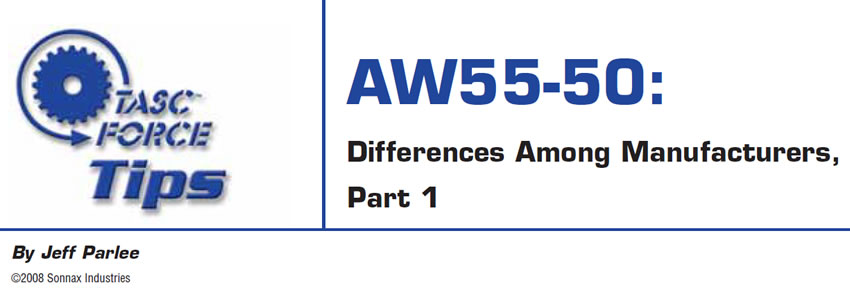
Tips for Quality Rebuilding
Have you ever wondered why some rebuilders never seem to have a comeback? Their units are installed, test driven and delivered time after time without any problems. Their success is the result of a combination of things that any transmission rebuilder with motivation and good skills can do.
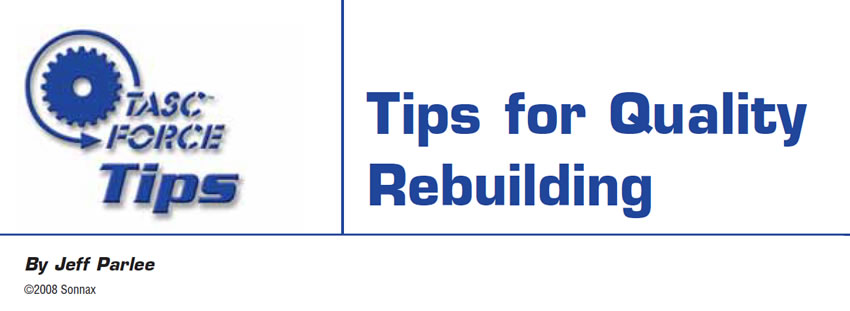
Avoiding After-Overhaul Problems
Being an R&R technician is challenging work. Even worse, you can make the job harder with one little slip or missed step. All it takes is forgetting to disconnect a wiring harness before dropping the transaxle: Before you know it, the transmission jack is coming down but the transaxle is suspended in mid-air by the harness. Once the transaxle is repaired and installed in the car, you have to diagnose and repair some new electrical problems that were not there before the rebuild. You can avoid this mistake and many others by new technicians by providing them with just a little training and a basic checklist of things that have to be done during every removal and installation of a transmission.

Diagnosis with Pressure Gauges
Not too many years ago, before computers found their way into cars, the pressure gauge was the technician’s main diagnostic tool. The pressure gauge can check pump capability, line rise, pressure-regulator and pressure-boost-valve operation, minimum line pressure and maximum line pressure. You can even see a crack in the filter neck on a pressure gauge without pulling the pan! Did you know that with the help of a pressure gauge you can get a good idea of whether non-OEM frictions were used during a rebuild, causing a harsh upshift?

